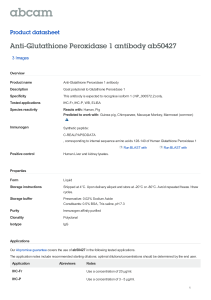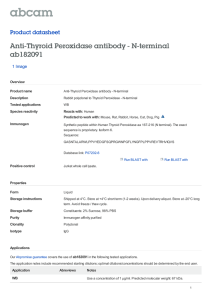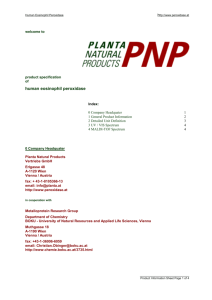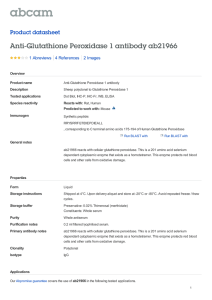Document 14262864
advertisement
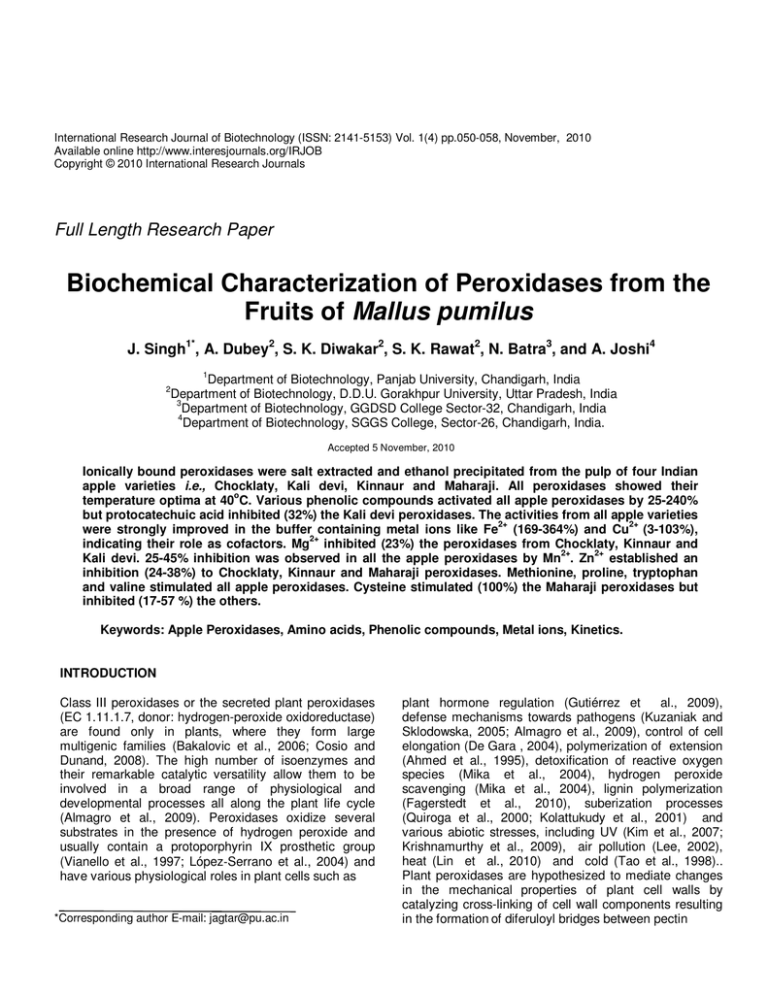
International Research Journal of Biotechnology (ISSN: 2141-5153) Vol. 1(4) pp.050-058, November, 2010 Available online http://www.interesjournals.org/IRJOB Copyright © 2010 International Research Journals Full Length Research Paper Biochemical Characterization of Peroxidases from the Fruits of Mallus pumilus J. Singh1*, A. Dubey2, S. K. Diwakar2, S. K. Rawat2, N. Batra3, and A. Joshi4 1 Department of Biotechnology, Panjab University, Chandigarh, India Department of Biotechnology, D.D.U. Gorakhpur University, Uttar Pradesh, India 3 Department of Biotechnology, GGDSD College Sector-32, Chandigarh, India 4 Department of Biotechnology, SGGS College, Sector-26, Chandigarh, India. 2 Accepted 5 November, 2010 Ionically bound peroxidases were salt extracted and ethanol precipitated from the pulp of four Indian apple varieties i.e., Chocklaty, Kali devi, Kinnaur and Maharaji. All peroxidases showed their temperature optima at 40oC. Various phenolic compounds activated all apple peroxidases by 25-240% but protocatechuic acid inhibited (32%) the Kali devi peroxidases. The activities from all apple varieties 2+ 2+ were strongly improved in the buffer containing metal ions like Fe (169-364%) and Cu (3-103%), 2+ indicating their role as cofactors. Mg inhibited (23%) the peroxidases from Chocklaty, Kinnaur and Kali devi. 25-45% inhibition was observed in all the apple peroxidases by Mn2+. Zn2+ established an inhibition (24-38%) to Chocklaty, Kinnaur and Maharaji peroxidases. Methionine, proline, tryptophan and valine stimulated all apple peroxidases. Cysteine stimulated (100%) the Maharaji peroxidases but inhibited (17-57 %) the others. Keywords: Apple Peroxidases, Amino acids, Phenolic compounds, Metal ions, Kinetics. INTRODUCTION Class III peroxidases or the secreted plant peroxidases (EC 1.11.1.7, donor: hydrogen-peroxide oxidoreductase) are found only in plants, where they form large multigenic families (Bakalovic et al., 2006; Cosio and Dunand, 2008). The high number of isoenzymes and their remarkable catalytic versatility allow them to be involved in a broad range of physiological and developmental processes all along the plant life cycle (Almagro et al., 2009). Peroxidases oxidize several substrates in the presence of hydrogen peroxide and usually contain a protoporphyrin IX prosthetic group (Vianello et al., 1997; López‐Serrano et al., 2004) and have various physiological roles in plant cells such as *Corresponding author E-mail: jagtar@pu.ac.in plant hormone regulation (Gutiérrez et al., 2009), defense mechanisms towards pathogens (Kuzaniak and Sklodowska, 2005; Almagro et al., 2009), control of cell elongation (De Gara , 2004), polymerization of extension (Ahmed et al., 1995), detoxification of reactive oxygen species (Mika et al., 2004), hydrogen peroxide scavenging (Mika et al., 2004), lignin polymerization (Fagerstedt et al., 2010), suberization processes (Quiroga et al., 2000; Kolattukudy et al., 2001) and various abiotic stresses, including UV (Kim et al., 2007; Krishnamurthy et al., 2009), air pollution (Lee, 2002), heat (Lin et al., 2010) and cold (Tao et al., 1998).. Plant peroxidases are hypothesized to mediate changes in the mechanical properties of plant cell walls by catalyzing cross-linking of cell wall components resulting in the formation of diferuloyl bridges between pectin Singh et al. 051 residues and isodityrosine bridges between hydroxyproline-rich extensin molecule (Deepak et al., 2010). Color, flavor, texture and nutritional value are four attributes considered by consumers in evaluating food quality. Color may be influenced by naturally occurring pigments such as chlorophylls, carotenoids and anthocyanins in food, or by pigments resulting from both enzymatic and non-enzymatic reactions. Enzymatic browning results mostly from polyphenol oxidase (PPO, EC 1.10.3.1) and peroxidase (Šukalović et al., 2010; Slatnar et al., 2010). Thus, the control of activities of these enzymes is very importance in preservation of foods (Prabha and Patwardhan, 1986; Clement and Robinso, 1995).Besides these peroxidases play important role in the estimation of blood sugar and cholesterol, immunoassays, biosensors (Hamid and Khalil-ur-Rehmana, 2009), treatment of waste water containing phenols and aromatic amines (Husain and Husain, 2008; Hamid and Khalil-ur-Rehmana, 2009), biobleaching processes (Machii et al., 2006), lignin degradation in fuel, production of dimeric alkaloids, oxidations, and biotransformation of organic compounds (Kumar et al., 2008). In the present study, we have discussed the biochemical characterization of peroxidases from apple varieties (Chocklaty, Kali devi, Kinnaur and Maharaji. Kali devi) of India. EXPERIMENTAL Experimental Plant Materials Various varieties of apples i.e., Chocklaty, Kali devi, Kinnaur and Maharaji were collected at their ripened stage from different parts of Northern India. The fruits were cleaned with sterile water, peeled and pulp was obtained. Preparation of Crude Enzyme Juice was separated after crushing 250 gm of apple pulp with a mortar and pestle and pressed through cheesecloth. Pulp was suspended in 125 mL of salt solution (0.5 M CaCl2, 0.5 M NaCl, and 0.125 M MgCl2) for one hour at room temperature. The suspension was passed through the cheesecloth and the filtrate was centrifuged at 15,000 rpm for 15 min. The supernatant was collected and used as a source of crude enzyme (Kumar et al., 2008). Solvent Precipitation The crude enzyme was precipitated with double volume of chilled absolute ethanol and centrifuged at 15,000 rpm for 15 min. Pellets were collected, dissolved in 10 mL of deionised water, and used as a source of ionically bound peroxidases (Kumar et al., 2008). Enzyme Assay Peroxidase activity was measured by a change in absorbance at 470 nm, due to oxidation of o-dianisidine (250 µl) in the presence of hydrogen peroxidase (500 nM) in one milliliter reaction mixture (Dubey et al., 2007). One unit of enzyme activity is defined as the amount of enzyme producing a 0.001 absorbance change per minute under the standard assay conditions (Kumar et al., 2008; Dalal et al., 2010). Determination of Temperature Optima and Thermal Stability To determine the optimum temperature, various peroxidases were incubated with substrate in the temperature range of 20-80oC and the activity was measured (Kumar et al., 2008; Dalal et al., 2010). Stability of enzyme was determined by incubating peroxidase, substrates and buffer for 30 min, samples were withdrawn at regular intervals of time, rapidly cooled in an ice bath, and residual activity was calculated. Determination of pH Optimum Sodium acetate (4.0–6.0) and Tris-HCl (pH 7-9) buffers (100mM) were used under standard assay conditions for determining optimum pH ( Dubey et al., 2007 ; Márquez et al., 2008; Motamed et al.,2009).The relative peroxidase activity (%) was calculated after assaying the enzyme at different buffers. Effect of Effectors (Metal Ions, Phenolic Compounds and Amino Acids) Metal ions (FeSO4, CuSO4, MgSO4, MnCl2, ZnSO4: 04mM), amino acids (cysteine, methionine, proline, 052 Int.Res.J.Biotechnol. tryptophan, valine: 0-10 mM) and phenolic compounds like hydroxycinemic acid derivatives such as caffeic acid (0–0.45 mM), ferulic acid (0–3.5 mM), p-coumaric acid (0–6.0 mM), and a hydroxybenzoic acid derivative like protocatechuic acid (0–6.0 mM) was incubated with fixed enzyme concentrations and the relative activity (%) was measured (Kumar et al., 2008). Determination of Kinetic Constants The apparent KM and Vmax were determined from the Lineweaver-Burk plot at optimum pH and temperature conditions (Kumar et al., 2008). RESULTS AND DISCUSSION Effect of pH Figure 1 showed pH optima of 4.5 for all apple peroxidases, however another pH optima was recorded for Chocklaty (6.0), Kali devi and Kinnaur (7.0) peroxidases indicating the possibilities of isozymes (Dubey et al., 2007) obtained pH optima in the range of 5.0-7.0 from other apple varieties i.e., Golden delicious HP, Golden delicious JK, Red delicious and Royal delicious. Similarly a broad pH range from 5.0 to 7.0 was determined by Deepak et al. (2010) for silk peroxidase. Acidic pH optima of the peroxidases were reported from vegetable sources (Vamos-Vigyazo,1981 ; Motamed et al., 2009), Cassia didymobotrya (Vitali et al., 1998) and soyabean (Kamal and Behere, 2003 ; Ryan et al., 2006). A maximal reduction of beta strands and beta turns at pH 5.5, causing the haem to be further exposed to the solvent and increasing the overall conformational flexibility of the protein (Kamal and Behere, 2003). Effect of Temperature and Thermostability All the apple peroxidases i.e. Chocklaty, Kinnaur, Kali Devi and Maharaji peroxidase observed optimum temperature and thermostability a 40oC (Figure 2). Dubey et al. (2007) observed temperature optima and thermostability in the range of 50-60oC for all the apple varieties. Reversible conformations in cases of horse radish peroxidases were observed between 20–55oC, while their activity was lost at a temperature of 60oC or above (Artiukhov et al., 2003 ; Kumar et al ., 2008). Heat lability of apple peroxidase in the present study was supported by Dubey et al. (2007) and Moulding et al. (1987). Similar thermostability was also reported in the peroxidases of peach (Neves and Lourenc, 1990), apple (Dubey et al., 2007), papaya (Silva et al., 1990), orange (Mohamed et al., 2008), ricinus, (Kumar et al., 2008) and turnip (Dalal et al., 2010). Effect of Effectors (Metal Ions, Phenolic Compounds and Amino Acids) The effect of metal ions on peroxidase activity is shown in Figure 3. All apple peroxidases were strongly stimulated with Fe2+ recording maximum increase of 364% with Kali devi variety, however, Cu2+ increased the activity in the range of 3-103%, thereby, indicating their potential role as cofactor. Zaalishvili et. al. (1990) observed that at low Cu2+ concentrations, the binding of these ions to the high-affinity sites of the enzyme increases the polymerase activity, whereas at high Cu2+ concentrations, the binding may also occur to sites with a lower affinity for the metal, which results in the inhibition of the enzyme activity. Dubey et al. (2007) recorded similar trends of stimulation for Fe2+ and Cu2+. Mg2+ recorded 23% inhibition (2-3 mM) in Chocklaty, Kinnaur and Kali devi peroxidases but slight activation (4%) was established for Maharaji. Dubey et al. (2007) observed 2.5 fold more inhibition for Mg2+. Mn2+ inhibited (25-45% at 1-4 mM) all the apple peroxidases. This study was similar to other apple peroxidases (Dubey et al., 2007) and large lima bean seed peroxidases (Wang 2+ et al., 2008). Zn established an inhibition (24-38% at 2-4 mM) to Chocklaty, Kinnaur and Maharaji peroxidases but Kali devi peroxidases observed a slight stimulation. Dubey et al. (2007) observed comparatively less inhibition but Wang et al. (2008) recorded a stimulation to large lima bean seed peroxidases in the 2+ presence of Zn . Further stimulation of 25-240% was showed for all apple peroxidases with caffeic acid, ferulic acid and pcoumaric acid (Figure 4). These results are similar to other apple peroxidase (Dubey et al., 2007).Similarly types of results were also established for Ricinus peroxidase in the presence of ferulic acid and (0.02-0.08 µM) and caffeic acid (1.0-4.5 µM) (Kumar et al., 2008). Protocatechuic acid showed 32% inhibition for Kali devi peroxidase, marginal stimulation of 3 and 10% to Chocklaty and Kinnaur peroxidases and 100% stimulation to Maharaji peroxidase. Similar results were reported by Dubey et al. 2007. Similarly, the derivatives Singh et al. 053 Figure 1. Effect of pH on the activity of apple peroxidases. of hydroxybenzoic acid (protoctatechuic acid) act as potent inhibitor for Ricinus peroxidases (Kumar et al., 2008). Methionine, proline, and valine stimulated (38-260% at 2.5-10 mM) all apple peroxidases (Figure 5).These results are similar to other apple peroxidases (Dubey et al., 2007). L-cysteine inhibited peroxidases from Kali devi (57% at 5.0 mM), Chocklaty (21% at 2.5 mM) and Kinnaur (17% at 5.0 mM) but stimulated the Maharaji (100% at 2.5 mM) peroxidases. Dubey et al. (2007) reported similar results in the presence of Methionine, proline and valine but L-cysteine observed 12% more inhibition for peroxidases from Golden delicious JK and stimulated the rest of the varieties (4-55%). Similarly DLmethionine and DL-valine worked as inhibitors for Ricinus peroxidase at 4.0 mM concentration while Lcyteine worked as a potent inhibitor at a very low concentration (0.4 mM). However, D-alanine and Lproline activated the of Ricinus peroxidase activity (Kumar et al., 2008). The apparent KM (substrate concentration at 1/2 the maximum velocity) and Vmax were determined from Lineweaver-Burk plots (1/V vs 1/[S]) by following the standard assay conditions at optimum temperature and pH conditions (Kumar et al., 2008). Higher value of Vmax/Km of Chocklaty, Kali devi, Kinnaur and Maharaji indicated a preferential action of the enzyme for hydrogen peroxide as compared to o-dianisidine (Table 1). Similar findings were also observed by Dubey et al. (2007) on other apple peroxidases. Contrary results were reported from peroxidases of papaya (Silva et al., 1990), ricinus (Kumar et al., 2008) and kiwifruit (Soda et al., 1991). CONCLUSION This paper established some unique finding in comparison to previous study on apple peroxidases. Ionically bound peroxidases extracted from four Indian apple varieties i.e., Chocklaty, Kali devi, Kinnaur and Maharaji showed their temperature optima and o thermostability at 40 C. Mild inhibition was observed for all the apple peroxidases in the presence of Mn2+. Zn2+ stimulated the Kali devi peroxidase and inhibited the others. Cysteine stimulated the Mahraji peroxidase and inhibited all other peroxdases. Protocatechuic acid inhibited Kali devi peroxidases and stimulated the others. ACKNOWLEDGMENT The authors are highly thankful to D.D.U. Gorakhpur University, Gorakhpur (Uttar Pradesh), India for providing the research grants. 054 Int.Res.J.Biotechnol. (B) (A) o 80 Relative Activity (%) Relative Activity (%) 100 40 C 50oC 60oC o 70 C 100 60 40 20 o 40 C 50oC o 60 C 70oC 60 40 20 0 0 0 10 20 Incubation Time (Minutes) 30 0 10 20 30 Incubation Time (Minutes) (C) (D) 180 40oC 50oC 60oC 70oC 80 60 40 20 160 Relative Activity (%) 100 Relative Activity (%) 80 140 120 100 80 40oC 50oC 60oC 70oC 60 40 20 0 0 0 10 20 30 Incubation Time (Minutes) Figure 2. Temperature stability of apple peroxidases. A): Temperature stability of Chocklaty peroxidase. B): Temperature stability of Kali devi peroxidase. C): Temperature stability of Kinnaur peroxidase. D): Temperature stability of Maharaji peroxidase. 0 10 20 Incubation Time (Minutes) 30 Singh et al. 055 B A 50 0 50 0 0 .6 40 0 30 0 20 0 4 .0 0 30 0 2 .0 20 0 0 10 0 4 .0 D 500 400 400 Relative activity (%) C 0.5 200 3.0 0 ZnSO4 MnCl2 MgSO4 M e ta l io ns (m M ) 500 300 CuSO4 Control ZnSO4 MnCl2 MgSO4 CuSO4 FeSO4 Control M e tal io ns (m M ) 2.0 2.0 0 .5 300 200 2 .0 0 4 .0 100 4.0 2 .0 4 .0 Metal ions (mM) ZnSO4 MnCl2 MgSO4 Control ZnCl2 MnCl2 MgSO4 CuSO4 FeSO4 Control CuSO4 0 0 FeSO4 Relative activity (%) 1 .0 0 0 100 3 .0 2 .0 3.0 1 .0 FeSO4 10 0 40 0 Realtive activity (%) Relative activity (%) 0.5 M e tal io n s (m M ) Figure 3. Effect of metal ions on the apple peroxidases. A): Effect of metal ions on the peroxidase of Chocklaty. B): Effect of metal ions on the peroxidase of Kali devi. C): Effect of metal ions on the peroxidase of Kinnaur. D): Effect of metal ions on the peroxidase of Mahraji. A B 400 400 0.45 3.0 200 0 1.0 3.5 300 200 100 2.0 0 1.0 Phenolic com pounds (µM) Protocatechuic p-coumaric Ferulic Protocatechuic p-coumaric Ferulic Caffeic Phenolic compounds (µM) Caffeic 0 0 Control 100 3.0 Relative activity (%) 300 Control Relative acitivity (%) 0.225 C D 400 40 0 300 Relative activity (%) 5.0 200 5.0 0 10.0 10.0 7 .5 5 .0 2 .5 7.5 2.5 20 0 0 10 0 2.5 0 Amino acids (mM) Val Trp Pro Control Val Trp Pro Met Control Cys 0 Met 100 30 0 Cys Relative activity (%) 056 Int.Res.J.Biotechnol. A m in o acid s (m M ) Figure 4. Effect of phenolic compounds on the apple peroxidases. A): Effect of phenolic compounds on the peroxidase of Chocklaty. B): Effect of phenolic compounds on the peroxidase of Kali devi. C): Effect of phenolic compounds on the peroxidase of Kinnaur. D): Effect of phenolic compounds on the peroxidase of Maharaji. B A 400 400 2.5 300 7.5 250 2.5 200 5.0 150 100 0 Relative acitivity (%) Relative activity (%) 350 2.5 300 2.5 200 10.0 7.5 100 5.0 0 5.0 50 D 40 0 300 Relative activity (%) C 400 5 .0 200 5 .0 0 1 0 .0 1 0 .0 Val Trp Pro Amino acids (mM) 30 0 7 .5 5 .0 2 .5 7 .5 2 .5 20 0 0 10 0 2 .5 Figure 5. Effect of amino acids on the apple peroxidases. A): Effect of amino acids on the peroxidase of Chocklaty. B): Effect of amino acids on the peroxidase of Kali devi. C): Effect of amino acids on the peroxidase of Kinnaur. D): Effect of amino acids on the peroxidase of Mahraji. A m i n o a c i d s (m M ) Val Trp Pro Met Val Trp Pro Met Cys Control A m in o a c id s (m M ) Cys 0 0 Control 100 Met Control Val Trp Pro Met Cys Control Relative activity (%) Amino acids (mM) Cys 0 0 Singh et al. 057 Table 1. Kinetics of ionically bound peroxidases from different apple varieties of India. Apple Varieties Chocklaty Kali devi Kinnaur Maharaji o-dianisidine Vmax/ KM (Units/min/mL) 117 50 40 357 REFERENCES Ahmed N, Chaplin M, Trevan M, Dey PM, Brownleader MD (1995).Purification and Partial Characterization of ‘Extensin Peroxidase’. Biochem. Soc. Trans. 23 (2): 154S. Artiukhov VG, Basharina OV, Iskusnlykh A (2003).Effect of Temperature on Structure and Functional Properties of Horseradish Peroxidase. Ukr. Biokhim .Zh.75 (3):45-49. Almagro L, Gómez Ros LV, Belchi-Navarro S, Bru R, Ros Barceló A, Pedreño MA (2009).Class III peroxidases in plant defence reactions. Journal of Experimental Botany 60: 377–390. Bakalovic N, Passardi F, Ioannidis V, Cosio C, Penel C, Falquet L, Dunand C (2006).A Class III Plant Peroxidase Database.Phytochemistry. 67: 534–539. Clement E, Robinson DS (1995).The Termostability of Purified Oranges Isoperoxidase. Arquivos de Biologia e Tecnologia,Campinas. 38: 1109–1118. Cosio C, Dunand C (2008). Specific functions ofindividual class III peroxidase genes. J. Exp BOt. 60(2):391-408. De Gara L(2004).Class III peroxidases and ascorbate metabolism in plants. Phytochemistry Reviews .3(1-2): 195-205. Dubey A , Diwakar SK, Rawat SK, Kumar P, Batra N, Joshi A, Singh J (2007).Characterization of Ionically Bound Peroxidases from Apple (Mallus pumilus) Fruits. Prep. Biochem.&Biotechnol. 37: 1-12. Deepak S , Shailasree S, Kini RK, Muck A, Mithöfer A, Shetty SH (2010).Hydroxyproline-rich Glycoproteins and Plant Defence.J.Phytopathology.158(9):585-593. Dalal S,Gupta MN (2010).Purification and Characterization of a Peroxidase Isozyme from Indian Turnip Roots.J. Agric. Food Chem.58(9):5545–5552. Fagerstedt KV, Kukkola EM, Koistinen VT, Takahashi J, Marjamaa K (2010). Cell WallLignin is Polymerised by Class III Secretable Plant Peroxidases in Norway Spruce .J. Integative Plant Biology.52(2):186-194. Gutiérrez J, María Josefa López Núñez-Flores, Gómez-Ros LV, Uzal EN, Carrasco AE, Díaz J, Sottomaor M, Cuello J , Barceló AR (2009).Hormonal regulation of the basic peroxidase isoenzyme from Zinni elegans. 230(4):767-778. Husain M,Husain Q(2008). Applications of redox mediators in the treatment of organic pollutants by using oxidoreductive enzymes.A review Crit. Rev. Environ. Sci.Technol.38:1– 42. Hamid M, Khalil-ur-Rehman (2009).Potential applications of peroxidases. Food Chemistry.115(4): 1177-1186. Kolattukudy PE,Mohan R, Bajaj AA, Schert BA (2001).P.E.Polyester in Higher Plants.In Advances in Biochemical Engineering/Biotechnology1–49. Kamal JK,Behere DV(2003).Activity, Stability and Conformational Flexibility of Seed Coat Soybean Peroxidase. J. Inorg. Biochem. 94(3): 236–242. Kuzaniak E, Sklodowska M (2005). Fungal Pathogen-induced Changes in the Antioxidant Systems of Leaf Peroxisomes from Infected Tomato Plants. Planta 222(1): 192–200. H2O2 Vmax/ KM (Units/min/mL) 30,769 29,386 51,760 66,138 Kim YH, Lim S , Han SH, Lee JC, Song WK, Bang JW, Kwon SY, Lee HS , Kwak SS (2007).Differential expression of 10 sweetpotato peroxidases in response to sulfur dioxide, ozone, and ultraviolet radiation.Plant Physiology and Biochemistry. 45(12): 908-914. Kumar P,Kamle M, Singh J, Rao DP (2008).Isolation and characterization of peroxidase from the leaves of Ricinus communis .J. Biotechnology and Biochemistry. Krishnamurthy P, Ranathunge K, Franke R, Prakash HS, Schreiber L, Mathew MK (2009).The role of root apoplastic transport barriers in salt tolerance of rice (Oryza sativa L.).Planta 230(1): 119-134. Lee M Y (2002).Effect of Na2SO3 on the Activitie s of Antioxidant Enzymes in Geranium Seedlings.Phytochemistry.59: 493–499. López‐Serrano M, Fernández, MD, Pomar F, Pedreño MA, Barceló AR(2004). Zinnia elegans uses the same peroxidase isoenzyme complement for cell wall lignifications in both single-cell tracheary elements and xylem vessels .J.Experimental Botany .55:423-431. Lin KH,Huang HC, Lin CY (2010). Cloning expression and physiological analysis of broccoli catalase gene and Chinese cabbage ascorbate peroxidase gene under heat stress.Plant Cell Reports.29(6):575-593. Moulding, PH, Grant HF, McLellan KM,Robinson DS (1987). Heat Stability of Soluble and Ionically Bound Peroxidases Extracted from Apples. Intl. J. Food Sci. Technol. 22: 391–397. Mika A, Minibayeva F, Beckett R and Lüthje S (2004).Possible functions of extracellular peroxidases in stress-induced generation and detoxification of active oxygen species. Phytochemistry .Reviews .3(1-2):173-193. Machii Y, Hirai H, Nishida T (2006). Lignin peroxidase is involved in the biobleaching of manganese-less oxygen-delignified hardwood kraft pulp by white-rot fungi in the solid-fermentation system FEMS Microbiology Letters. 233(2):283-287. Márquez O, Waliszewski KN , Oliart RM, Pardio VT (2008).Purification and characterization of cell wall-bound peroxidase from vanilla bean. LWT - Food Science and Technology. 41(8):1372-1379. Mohamed SA, El-Badry MO, Drees EA and Fahmy AS.(2008).Properties of a Cationic Peroxidase from Citrus jambhiri cv. Adalia.Applied Biochemistry and Biotechnology.150 :127-137. Motamed S,Ghaemmaghami F and Alemzadeh I(2009). Turnip (Brassica rapa) Peroxidase: Purification and Characterization .Ind. Eng.Chem..48(23):10614–10618. Neves VA,Lourenc EJ (1990). Peroxidase from Peach Fruit: Thermal Stability. Braz. Arch. Biol. Technol. 41 (2): 179–186. Prabha TN,Patwardhan MV (1986). Polyphenoloxidase(PPO) and Peroxidase (POD) Enzyme Activities and their Isoenzyme Patterns in Ripening Fruits. Acta Alimentaria. 15: 199–207. Quiroga M, Guerrero C, Botella MA, Barcelo Amaya I, Meina MI, Alonso FJ, d Fronhetti SM, Tigier H, Valpuesta VA (2000). A Tomato Peroxidase Involved in the Synthesis of Lignin and Suberin. Plant Physiol. 122: 119–1127. Ryan BJ, Carolan N, O'Fágáin C (2006).Horseradish and soybean peroxidases. Trends Biotechnol. 24:355–363. Silva E, Lourenc EJ, Neves VA (1990).Soluble andBound Peroxidase 058 Int.Res.J.Biotechnol. from Papaya Fruit.Phytochemistry .29: 1051–1056. Soda I, Hasegawa T, Suzuki T, Ogura N (1991).Purification and Some Properties of Peroxidase from Kiwifruit. Agric. Biol. Chem. 55: 1677–1678. Šukalović VHT, Veljović-Jovanović S , Dragišić Maksimović J , Maksimović V, Pajić Z (2010).Characterisation of phenol oxidase and peroxidase from maize silk.Plant Biology. 12(3):406-413. Slatnar A, Mikulic Petkovsek M, Halbwirth H , Stampar F, Stich K, Veberic (2010). Enzyme activity of the phenylpropanoid pathway as a response to apple scab infection. Annals of Applied Biology.156(3):449-456 Tao DL, Oquist G, Wingsle G (1998). Active Oxygen Scavengers during Cold Acclimation of Scots Pine Seedlings in Relation to Freezing Tolerance.Cryobiology. 37 (1): 38–45. Vamos-Vigyazo L (1981). Polyphenol Oxidase and Peroxidase in Fruits and Vegetables. CRC Crit. Rev. Food Sci. Nutr. 15: 49–127. Vianello A, Zanzani M, Nagy G, Macri F (1997).Guaiacol Peroxidase Associated to Soybean Root Plasma Membranes Oxidizes Ascorbate. J. Plant Physiol. 150: 573–577. Vitali A, Botta B, Delle Monache G, Zappitelli S, Ricciardi P, Melino S, Petruzelli R, Giardina B (1998). Purification and Partial Characterization of a Peroxidase from Plant Cell Cultures. 331: 513–519. Wang SY, Gong YS, Zhou JJ (2008). Chromatographic Isolation andCharacterization of a Novel Peroxidase from Large Lima Legumes. J. Food Science.74(3): 193-198. Zaalishvili TM, Dzhaparidze NS, Sabelashvili, DM, Michilashvili RD 2+ 2+ (1990). The effect of Cu , Zn cations and biogenic amines on the poly (ADP-ribose) polymerase activities of brain nuclei and on the NAD content in nerve tissues.Biokhimiia. 55(4): 695-64.
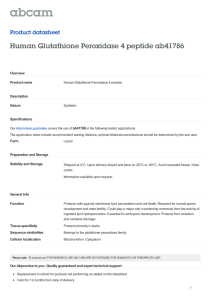
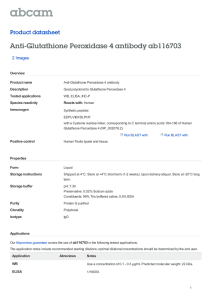
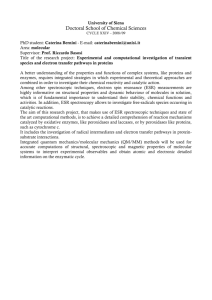
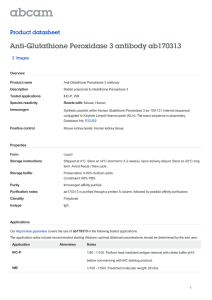
![Anti-Thyroid Peroxidase antibody [1.B.10] ab31829 Product datasheet Overview Product name](http://s2.studylib.net/store/data/011964745_1-5f75fbef9c57765583cc9a2be1b15b4b-300x300.png)
